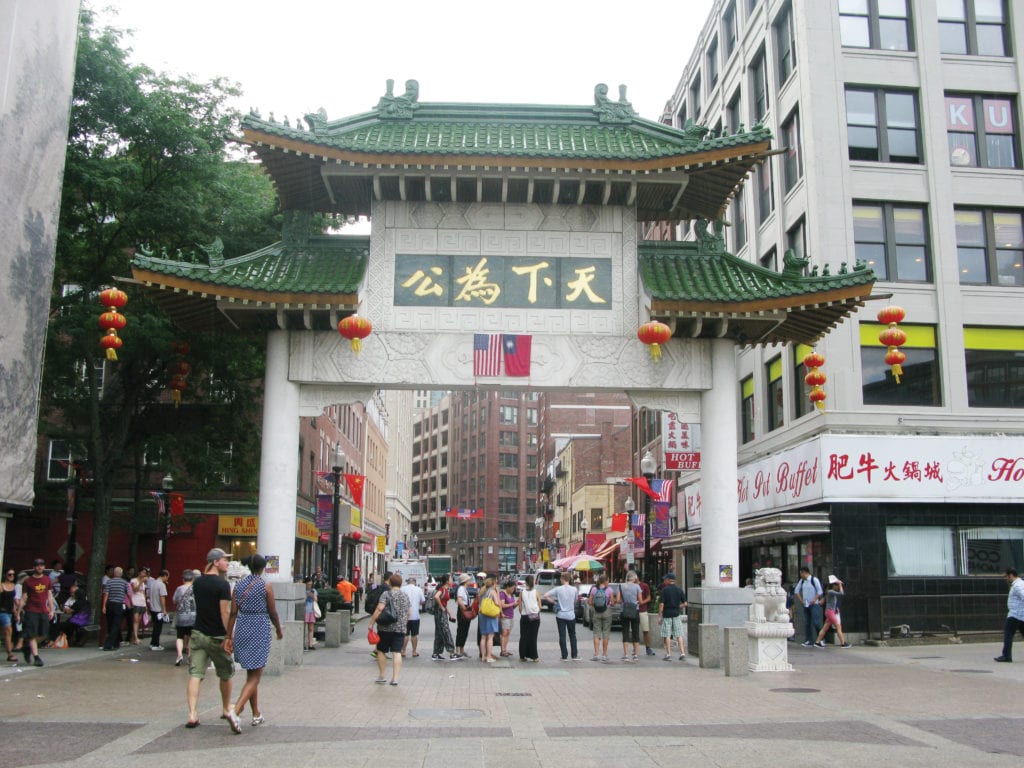
When taking a tour through Boston’s historic Chinatown, it is clear that the historic sites being pointed out along the way are under threat by developers taking advantage of the building boom.
The Chinese Historical Society of New England led a tour group through Chinatown last Friday, revealing much of Chinatown’s rich and complicated history.

The tour makes its way along a Chinatown side street. Photo: Saphia Suarez
In 1870, Chinese immigrants were first brought to Massachusetts from San Fransisco to break up a strike at the Sampson Shoe Factory in North Adams. Shortly after, they settled in what is now know as Chinatown, and many moved to Ping On Alley. Chinatown began to form along Ping On Alley and the streets surrounding it, including Harrison Avenue, which has the last single room occupancy building in Chinatown. The building was a boarding house, and likely housed men who came to Chinatown alone to work and send money home to their families back in China. Developers proposed turning the old boarding house into a hotel, which community members have protested against. Residents have been calling for more affordable housing, but developers continue to build luxury condominiums and hotels.
History of Chinatown
Chinatown housed Irish, Italian, and Syrian immigrant communities before a large Chinese population immigrated there and it was given the name we know today, explained the tour guide, a Tufts student from Shanghai named Jerry Chang.
The waves of immigrants coming to the United States from China increased during times of civil war and famine in China, and again after the Vietnam War. Most of Chinatown’s first immigrants were men, who came to the city from China to work and send money home to their families. Many exclusionary policies were put in place to stop Chinese people from immigrating to the United States, including the Chinese Exclusion Act passed in 1882.
Women began to join the workforce in Chinatown after a telephone switching station was built on the corner of Essex Street and Harrison Avenue. The telephone operator business revolutionized women’s roles in the workforce across the world, not just in Boston’s Chinatown.
Another historic street in Chinatown is Oxford Street, which was home to the only printing press in the city that printed in Cantonese. Chinese restaurants, businesses, and residents who needed printed flyers or documents in Chinese had to come to Oxford Street. On the same block is a brick wall that used to be the town bulletin board, where job notices and other updates would be posted.
Boston tried to evict the Chinese community in Chinatown but failed, and in the 1960s and ’70s the city designated Chinatown as the adult entertainment district. It was now home to the Red Light District, also known as the Combat Zone by the city of Boston.
Community Infrastructure
The community in Chinatown built many infrastructures to help Chinese immigrants to settle in Boston. The Greater Boston Golden Age Center was established in 1972 to serve the elderly community in Chinatown, after residents realized there was a lack of outreach to elderly people from China who faced a bigger barrier when they came to the United States.
Another way Chinese immigrants would find resources and establish themselves in a community was by finding the family association that corresponded with their surname. There were family associations for many common surnames, such as Wong and Lee. The Lee Family Association is still located on Taylor Street, which is lined with Chinese restaurants and shops with flashy signs and awnings advertising Chinese cuisine, much of which has been Americanized for non-Chinese customers.
When Chinatown first became established as a Chinese immigrant community in the 19th century, only people of Chinese descent would eat at Chinese restaurants, because many Americans had negative stereotypes about Chinese cuisine and culture. But Boston’s Chinatown is located near the theater district, and after late shows and rehearsals Chinese restaurants would often be the only businesses open, so actors and theater goers would come into Chinatown to eat. As would Jewish families, particularly on Christian holidays when most businesses were closed—this is likely where the Jewish tradition of having Chinese food on Christmas comes from.
Once non-Chinese customers started eating in Chinatown, the businesses changed their dishes to appeal to the American palate. Dishes became sweeter and doughier. Restaurant signs grew in size and Americanized their names to keep up with competition.
The tour ended at Chinatown Gate, which was donated by Taiwan during the Cold War, when China and Taiwan were competing to build the gates to Chinatowns across the country. There is a Taiwanese flag on the gate, signifying the donation.






